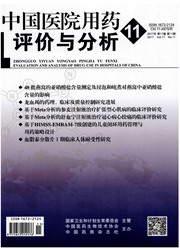

 中文摘要:
中文摘要:
目的:利用分子对接技术,探讨赤芍中的芍药苷、芍药内酯苷、丹皮酚等4种有效成分分别与法尼酯衍生物X受体(farnesoid X receptor,FXR)的相互作用。方法:采用Autodock 4.2软件进行分子对接。结果:得出芍药苷、芍药内酯苷、丹皮酚等与FXR蛋白1号位点和2号位点以及FXRα蛋白的结合结果。芍药苷、芍药内酯苷、丹皮酚与FXRα蛋白结合的自由能分别为-13.44、-21.77、-16.45 k J/mol,与FXR蛋白1号位点的自由能分别为-18.21、-48.60、-49.52 k J/mol,与FXR蛋白2号位点的自由能分别为-15.32、-24.70、-18.59 k J/mol。结论:芍药苷、芍药内酯苷、丹皮酚与FXR蛋白具有较小的自由能,即结合作用较强。提示赤芍治疗胆汁淤积型肝炎的作用机制可能为其主要成分与FXR受体蛋白具有较强结合作用,引起FXR调节其相应靶基因的表达,从而调控胆汁酸的合成和代谢以达到保肝利胆的作用,为进一步研究赤芍治疗胆汁淤积型肝炎的分子机制提供了理论参考。
 英文摘要:
英文摘要:
OBJECTIVE: To probe into the interactions of the main active ingredients in Radix paeoniae rubra as paeoniflorin,albiflorin,paeonol and farnesoid X receptor( FXR) based on molecular docking technology. METHODS:Autodock 4. 2 software was used for molecular docking. RESULTS: It was obtained that paeoniflorin,albiflorin and paeonal combined with FXR protein No. 1 spot and No. 2 spot and FXRα protein. The free energy of paeoniflorin,albiflorin and paeonol and FXRα protein binding were- 13. 44 k J / mol,- 21. 77 k J / mol and- 16. 45 k J / mol; for FXR protein No. 1 spot,the free energy were- 18. 21 k J / mol,- 48. 60 k J / mol and- 49. 52 k J / mol; for FXR protein No. 2spot,the free energy were- 15. 32 k J / mol,- 24. 70 k J / mol and- 18. 59 k J / mol. CONCLUSIONS: Paeoniflorin,albiflorin and paeonol and FXR protein have little free energy,which have strong binding. It is indicated that the mechanism of Radix paeoniae rubra in treatment of cholestatic hepatitis may be related to the strong binding of the main active ingredient paeoniflorin and FXR receptor protein,which can make FXR adjusts its corresponding expression of target genes so as to protect the liver by regulating the synthesis and metabolism of bile acid. This study provides a theoretical reference for the further study of TPG treatment with cholestatic hepatitis.
 同期刊论文项目
同期刊论文项目
 同项目期刊论文
同项目期刊论文
 Spectrum-effect relationships between UPLC fingerprints and bioactivities of five Aconitum L. plants
Spectrum-effect relationships between UPLC fingerprints and bioactivities of five Aconitum L. plants Fingerprint–efficacy study of Radix Aconiti Lateralis Preparata (Fuzi) in quality control of Chinese
Fingerprint–efficacy study of Radix Aconiti Lateralis Preparata (Fuzi) in quality control of Chinese Study on hot property differences of Aconiti Lateralis Radix Praeparata and its compatibility with d
Study on hot property differences of Aconiti Lateralis Radix Praeparata and its compatibility with d Microcalorimetry coupled with chemometric techniques for toxicity evaluation of Radix Aconiti Latera
Microcalorimetry coupled with chemometric techniques for toxicity evaluation of Radix Aconiti Latera Study on hot property of Aconiti Lateralis Radix Praeparata and its compatibility with Zingiberis Rh
Study on hot property of Aconiti Lateralis Radix Praeparata and its compatibility with Zingiberis Rh Spectrum-effect relationships between UPLC fingerprints and bioactivities of crude secondary roots o
Spectrum-effect relationships between UPLC fingerprints and bioactivities of crude secondary roots o Microcalorimetric investigation of five Aconitum L. plants on the metabolic activity of mitochondria
Microcalorimetric investigation of five Aconitum L. plants on the metabolic activity of mitochondria 期刊信息
期刊信息
